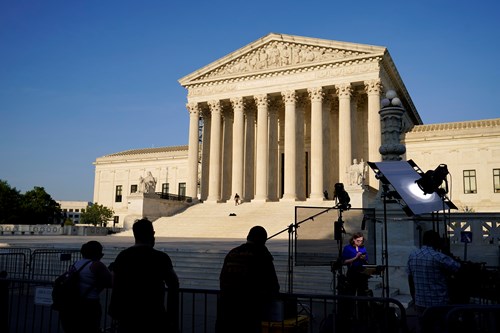The latest effort by a far-left Democratic senator to manipulate the Supreme Court would fail in the current climate, conservative analysts say – but it also highlights a problem with the nation’s top judicial body: it has become over-politicized. Michael Donnelly, a constitutional attorney, agreed on American Family Radio Thursday that that's a problem.
Legislation proposed by Sen. Ron Wyden (D-Oregon) would add six justices, make it more difficult for the Court to overturn laws, would change how nominees are approved for the Court and would mandate annual audits of each justice.
Does it have a chance on Capitol Hill?
Democrats control the White House and the Senate now, Republicans the House. The landscape always has potential for change, but for now, ConservativeBrief.com believes Wyden’s measure ("The Judicial Modernization and Transparency Act") has little chance to pass.
Nor should it, but success or failure of the legislation isn’t really the point, Donnelly told show host Jenna Ellis. He views the Supreme Court like referees in a football game: if they’re the ones being discussed, that’s a problem.
 “Should we be talking so much about the Supreme Court of the United States? Should this Court have so much power that it drives presidential elections; that it is, you know, who's on the Court is something that is debated on TV and by radio hosts and things of that nature? I would say the founders did not envision such a role for the Court,” Donnelly argued.
“Should we be talking so much about the Supreme Court of the United States? Should this Court have so much power that it drives presidential elections; that it is, you know, who's on the Court is something that is debated on TV and by radio hosts and things of that nature? I would say the founders did not envision such a role for the Court,” Donnelly argued.
Enacted by President George Washington in 1789, the U.S. Supreme Court first met as a branch of government in February 1790. Its first decision came in the case of West v. Barnes when it settled a financial dispute between a farmer and a family to which a debt was owed.
“Article 3 of the Constitution says there's one Supreme Court of the United States to decide cases and controversies, and it has jurisdiction over a variety of things. It was there to decide cases between citizens of different states, between the states themselves, which is why it's really irritating that the court did not take Texas v. Pennsylvania way back in 2020,” Donnelly said.
The Court chose not to hear the dispute between Texas and not only Pennsylvania but also Georgia, Michigan and Wisconsin. Texas Attorney Gen. Ken Paxton sued all four states saying they had unconstitutionally changed their voting laws and procedures during COVID-19, leading to widespread fraud and undermining the integrity of the election.
The case was dismissed for lack of standing, and the justices never heard it for its merits.
A ruling could have overturned Joe Biden’s 2020 election victory.
The Court has gradually become more powerful
That’s the kind of power the Supreme Court has accumulated over time, Donnelly says.
“The Court was never intended to be the final word on the Constitution. It was never intended to be a legislative body, striking down state laws or striking down the laws of Congress,” he explained.

Over time, however, the Court’s role – by virtue of its own decisions – changed.
“The role of the Court has become extremely powerful, especially after the Civil War with the 14th Amendment, which basically says in one of its clauses that no state shall deny a person life, liberty or property without due process of law or should the Court deny to anyone the equal protection of laws. The Court has interpreted that as giving it a lot of authority over the states. And so you see the Court getting involved in striking down state laws, striking down state constitutions,” Donnelly said.
But Congress has its own mandate to interpret the Constitution, Donnelly notes.
“In a particular case, the legislators need to then respond to the Court's opinions and say, ‘Okay, the Court says this isn't constitutional … do we agree with that? Because the other branches of government at the federal level have their own duty to interpret the Constitution and exercise their own constitutional authority.”
The make-up of the Supreme Court was a key talking point in the 2016 election with candidate Donald Trump going so far as to present a short list of jurists he would nominate.
Aside from Wyden’s proposal, Court has generated the same level of interest this cycle as key issues like the border, the economy and abortion make their way to the top of most voter interest polls.
However, it would not be shocking for two openings to occur during the next four years with Justices Clarence Thomas at 76 years old and Samuel Alito at 74. Both lean conservative.
“I think we know what kind of justices a President [Kamala] Harris would nominate,” Donnelly suggested. “We’d have more justices like Ketanji Brown Jackson [a Biden appointee] who doesn’t know the difference between a man and a woman and would be a political activist.”
Don’t remake the number, remake the process
Lifetime appointments cut both ways.
Donnelly notes that states have different ways – including elections – to appoint justices to their own high courts. The federal government could learn from them and should do away with lifetime appointments, he says.
“I think lifetime appointments is something we should do away with. Everything is political, let’s be real – and just saying they’re not supposed to be political isn’t going to change that," he offered.
"At least with elections the people have some say, and there is a way to hold [justices] accountable. When you have lifetime appointments [justices] can’t be removed except for bad behavior, which is almost never.”
There's something about the number 15
According to History.com, President Franklin D. Roosevelt attempted to "pack the court" in the 1930s when he proposed that all sitting Supreme Court justices over the age of 70 would be asked to resign – and if they refused, he would be allowed to nominate an additional justice to the bench.
Six of the nine justices at that time were older than 70 – creating the possibility of six new seats on the High Court, bringing the potential total to 15. The U.S. Senate shot down his proposal by a vote of 70-20.







